The State Council Information Office of China on Thursday published a white paper titled “Youth of China in the New Era.”
The white paper is the first of its kind focusing on China’s youth. The document records achievements in the country’s youth development in the new era, and reflects the spirit of its youth.
The following is the full text of the report.
Youth of China in the New Era
The State Council Information Office of the People’s Republic of China
April 2022
Contents
Preamble
I. The New Era: Great Times with Ample Opportunities
II. All-Round Development in the New Era
III. Shouldering Heavy Tasks and Responsibilities
IV. Having a Global Vision and a Strong Sense of Responsibility
Conclusion
Preamble
Youth is the most active and vital force in society. The hopes of a country and the future of a nation lie in the hands of its young generation. Young Chinese have always played a vanguard role in the quest for national rejuvenation.
After 1840, China was gradually reduced to a semi-colonial, semi-feudal society and suffered enormous hardships. The country endured intense humiliation, the people were subjected to great pain, and China’s civilization was plunged into darkness. China’s youth gradually came to recognize the mounting national crisis.
The enlightenment of its youth lit a beacon of hope for the rejuvenation of the Chinese nation. Around the May Fourth Movement in 1919, a large number of aspiring and progressive young intellectuals assumed the lead in accepting new ideas, new culture, and new knowledge. After careful consideration they chose to follow Marxism-Leninism, which led to a widespread awakening of the people and the nation for the first time since the Opium War. In July 1921, 13 delegates, of an average age of only 28, participated in the first National Congress of the Communist Party of China (CPC) and announced the founding of the Party, an epoch-making event that sounded the clarion call for the awakening and rise of the nation. This marked the beginning of a new era of national rejuvenation for China. Under the CPC’s leadership, the Communist Youth League of China (CYLC) was established in 1922, opening a new chapter of the Chinese youth movement.
Looking back on a century of relentless change, China’s youth have never wavered in their determination to love the Party, the country and the people, nor in their commitment to the original aspiration of following the instructions and guidance of the Party. During the New Democratic Revolution (1919-1949), they rose to the occasion without fear of death and fought bravely for national independence and the people’s liberation. During the socialist revolution and reconstruction (1949-1978), they endured hardships and dedicated themselves to building the newly-founded country. In the new period of reform, opening up and socialist modernization, those with a talent for innovation who were open to challenges stood out and forged ahead, led reform, and ensured that China progressed with the times.
The 18th CPC National Congress held in 2012 marks the beginning of a new era in the development of socialism with Chinese characteristics. The CPC Central Committee with Comrade Xi Jinping at its core attaches great importance to young people, and cares deeply about them, and fully trusts them. It is committed to the principle that the Party exercises leadership over youth, gives top priority to youth development, and ensures the CYLC plays its role to the full as an aide to the Party and a reserve force. This will enable the younger generations to develop fully and achieve historic progress. In this great new era, China’s youth have shown amazing vibrancy and great passion.
Young Chinese people in the new era are confident, aspirant and responsible. They wholeheartedly support the leadership of the Party. With a global vision, they stand at the forefront of the times bursting with commitment: pursuing lofty ideals with a firm belief in Marxism, communism and socialism with Chinese characteristics; full of patriotism, sharing weal and woe with the country and the people; displaying the sterling quality of living up to responsibilities; being the first in the country to worry about the affairs of the state and the last to enjoy themselves; striving to be pioneers in, pacesetters for and contributors to the country’s development.
History shows clearly that without the CPC, the Chinese youth movement would have achieved little. For China’s youth, commitment to the CPC is the most valuable experience, and the revolutionary traditions passed down are the most precious wealth accumulated over the past century.
In his speech addressing a ceremony celebrating the CPC centenary on July 1, 2021, Xi Jinping, general secretary of the CPC Central Committee, emphasized that “In the new era, our young people should make it their mission to contribute to national rejuvenation and aspire to become more proud, confident, and assured in their identity as Chinese people, so that they can live up to the promise of their youth and the expectations of our times, our Party and our people.”
We have stood at a new historical starting point and embarked on a new journey in achieving the rejuvenation of the Chinese nation. Looking ahead to the new era, China’s youth are embracing precious opportunities to realize their ambitions and display their talents, as they shoulder the important responsibility of building a great modern socialist country and realizing the Chinese Dream of national rejuvenation.
The Chinese Dream is a dream about history, the present and the future. It is cherished by all of the people, but even more so by the young. China’s youth in the new era will keep on striving with boundless energy, to turn the Chinese Dream of national rejuvenation into reality.
In order to fully showcase the vigorous image and the invaluable contribution of China’s youth in the new era, China is releasing this white paper on the occasion of the 100th anniversary of the founding of the CYLC.
I. The New Era: Great Times with Ample Opportunities
Great times make fine young people and flourishing ages nurture true talent. The Chinese nation has achieved a tremendous transformation from obtaining independence and becoming prosperous to growing in strength, and the current new era bestows prosperity and hope. China’s rejuvenation has become an unstoppable process.
Living in the best times in Chinese history, the current young generation enjoys an enabling environment for development, a broad space to grow, and wonderful opportunities to make a good career.
(1) Better Conditions for Development
China’s economic and technological influence and composite national strength keep growing, which offers a sound foundation for China’s youth to develop with increasing confidence.
Better material conditions. Affluence provides a good foundation for the young generation to develop and grow.
China has achieved two miracles – rapid economic growth and lasting social stability. In 2021, its economy ranked second in the world in size, with GDP exceeding 110 trillion yuan. As more than 25 million young people have escaped poverty, this generation can look forward to a better future of greater prosperity.
In pursuing a life of high quality, young people are changing their consumption habits from consuming mass products and services to customized ones. They are changing from buying to meet their basic needs to buying to enjoy life, from having clothing to wear to dressing fashionably, from having food to eat to eating well for good health, and from taking affordable transportation to choosing fast and comfortable vehicles. Their standard of living has seen qualitative changes and their prospects for development are supported by a solid material foundation.
Greater space for rich intellectual and cultural life. A rich and colorful intellectual and cultural life is a precondition for young people to prosper and grow.
With a growing number of libraries, museums, cultural centers, art galleries and other public cultural facilities being built,[ By the end of 2020, the number of registered museums had reached 5,788 across the country, with one new museum being opened every two days on average during the period 2016-2020.] young people now enjoy notably improved public cultural services. Instead of feeling amazed at any new place they visit, they are getting used to visiting all kinds of places, thus refining their cultural tastes. Through the buoyant growth of traditional cultural industries such as publishing, television, movies, and artistic performance, and emerging cultural sectors such as the digital creative industry, online audio and visual, digital publishing, digital entertainment and online performance and broadcasting, young people now find diverse public cultural products available to them. Instead of reading and watching whatever they could get hold of, they can read and watch whatever they would like, thus broadening their vision. As a huge variety of tourist products are created for them to choose, such as cultural tours, countryside tours, CPC heritage tours and international travel packages, their desire to travel around the world is now satisfied. Instead of affordable sightseeing trips near their homes, they can travel anywhere they wish, thus enriching their knowledge and experience. These expanding intellectual and cultural spaces offer greater possibilities for young Chinese to achieve more, set lofty goals, and refine their tastes.
Growing with the internet. The internet has profoundly shaped the current generation, and the current generation has also influenced the internet.
At the end of 2020, the number of netizens aged 6 to 18 reached 180 million in China, with the internet available to 94.9 percent of minors, and the gap in internet accessibility between cities and rural areas narrowed to 0.3 percentage point from 5.4 percentage points in 2018. The internet has become the “sixth sense” of contemporary young people and part of their lives, and offers them a space to grow.
Along with rapid popularization of the internet, more and more young people are using the internet to access information, exchange ideas, make friends, and shop, and their ways of learning, living and working are changing profoundly. Young people make up the majority of the users of short online videos, live-streaming viewers, and ride-hailing customers. As they become the main producers of information, consumers of services, and promoters of technologies related to cyberspace, they are exerting a tremendous influence on internet trends. In a complex online environment, young people are spreading positive energy and shaping new social trends in an effort to ensure a clean cyberspace.
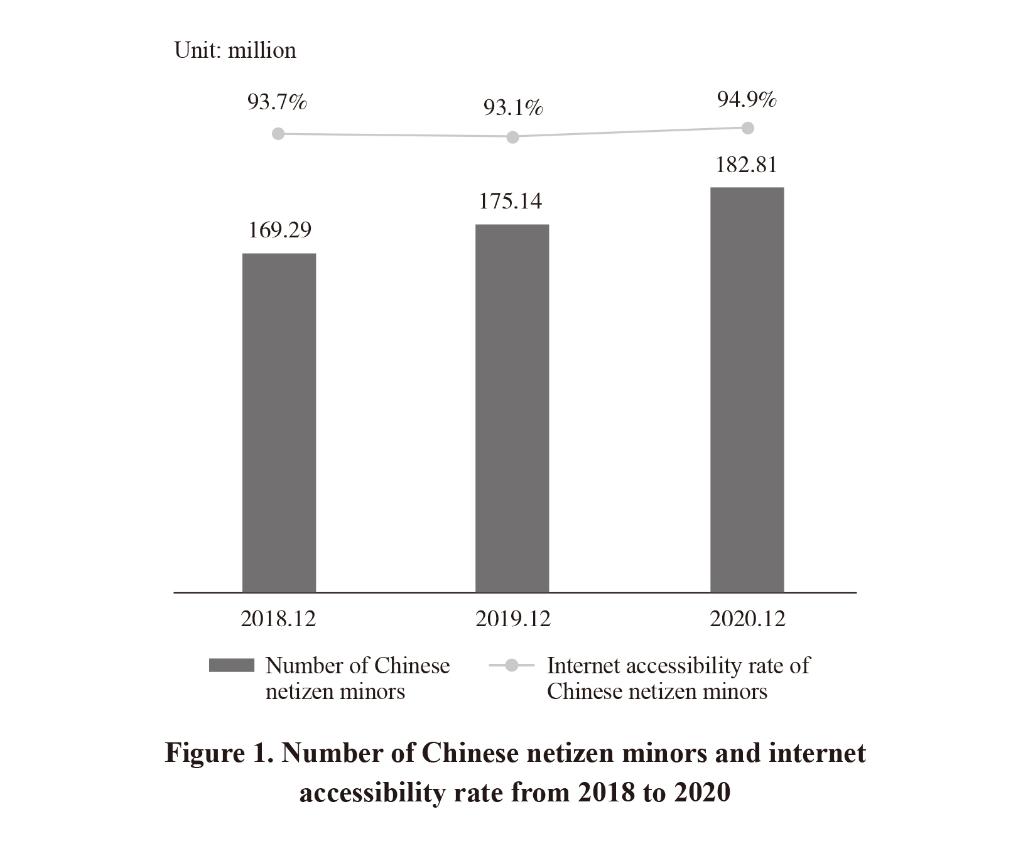
(2) More Opportunities to Fulfill Potential
Only when the country prospers can its young people prosper. With rapid economic and social development, young people in China in the new era have access to better opportunities for development and a growing stage on which to fulfill their potential.
Equal access to education. Young people in China enjoy more equal and higher-quality educational opportunities as the country continues giving high priority to education. In 2021, the completion rate of compulsory education in China reached 95.4 percent, the gross enrollment rate in senior secondary education reached 91.4 percent, and the gross enrollment rate in higher education reached 57.8 percent, with 44.3 million students on campus, ranking first in the world. More and more young people have stepped onto this important path to success and excellence.
The country has established and been improving the system of financial aid to students, which offers full coverage from preschool to postgraduate education. By 2020, subsidies had totaled over 240 billion yuan and assisted nearly 150 million students, achieving full coverage from preschool education, compulsory education, and senior secondary education to undergraduate and postgraduate education, across public and privately-run schools, and for all students from families with financial difficulties. The right of particular groups to receive compulsory education and their interests have been well protected, including children living in cities with their parents who are migrant workers, and students from rural and poor areas. In 2020, 85.8 percent of children living in cities with migrant worker parents studied in public schools or filled the slots purchased by the government in privately-run schools. From 2012 to 2021, more than 820,000 students from rural and poor areas were enrolled in key universities through special enrollment plans. More young people have thus been granted equal opportunities to receive better education, which prevents poverty from passing down from one generation to the next.
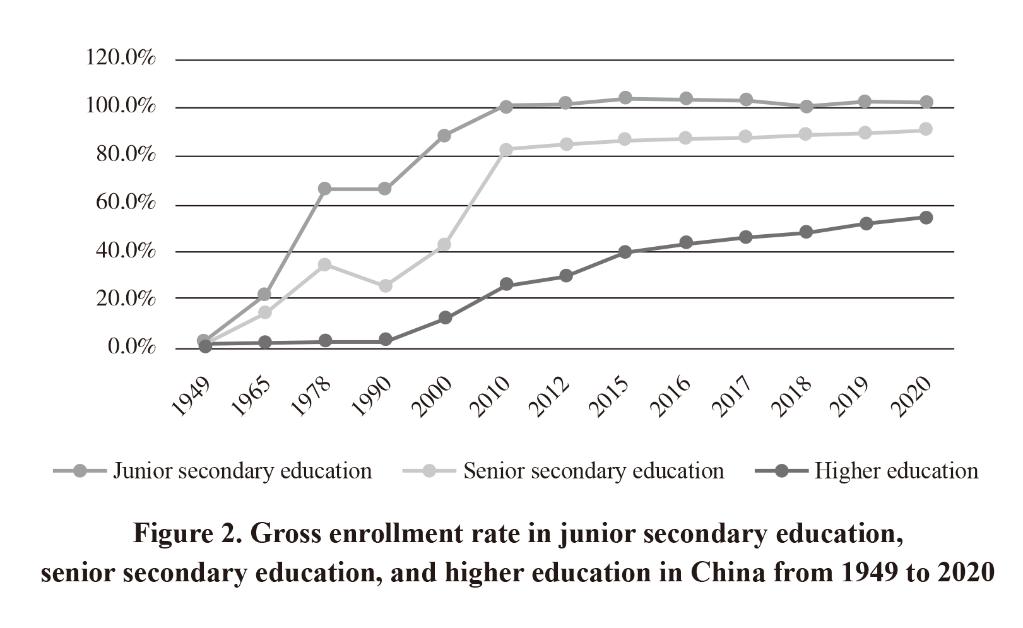
Diverse career options. The career choices of young people in China are increasingly diverse and market-oriented, and made, more often than not, on their own. Young people now look beyond a stable lifelong job in the traditional sense, and non-public economic entities and new social organizations are gradually becoming their main channels for employment. The options of “either workers or farmers” are a thing of the past, and the tertiary industry has become an important gathering place for the young workforce. In 2020, the tertiary industry employed 47.7 percent of those in employment across the country, up 13.1 percentage points from a decade ago. In particular, new and rapidly-rising industries and new business forms have given birth to a large number of new career options, such as esports players, live-streaming hosts, and web writers, and engaged a large number of young people in flexible employment, such as parcel and food couriers. There have emerged what they call “Slash” people with multiple titles, jobs, and ways of working and living. All these have testified to the greater range of opportunities and choices available to young people as times change.
Unimpeded mobility and more development opportunities. As the socialist market economy develops, the vitality of market players increases, and various factors of production flow more easily, young people enjoy more development opportunities and greater mobility. With the extension of the strategy for coordinated regional development, young people in China, who used to flock to economically developed southern and eastern regions of the country, have gradually diversified the target cities where they seek development opportunities and where they can fit in and thrive. Many young people from rural areas settle down and realize dreams in cities through hard work. In 2020, the number of migrant workers reached nearly 170 million and most of them were young people. Young permanent urban residents accounted for 71.1 percent of the total young population in the country, 15.3 percentage points higher than ten years ago and 7.2 percentage points higher than that of the permanent urban residents in the country’s total population. More young people are making their homes in the city and leaping forward in development through urbanization.
(3) More All-round Protection and Support
The development of young people calls for strong protection and support of the state. As fairness and justice in society have steadily improved and people’s rights and interests have been effectively safeguarded, young people in China in the new era can grow and prosper in a better legal environment and enjoy stronger policy support, more reliable social security, and greater care from a range of organizations.
Better legal protection. With progress in the rule of law in all respects, the system of the socialist rule of law with Chinese characteristics is steadily improving, providing strong protection for young people to develop. As the fundamental law of the country, China’s Constitution clearly stipulates that “the state shall foster the all-round moral, intellectual and physical development of young adults, youths and children”, which has laid a basic foundation for a legal framework to protect youth development. The youth development involves a wide range of areas and requires highly systematic, concerted efforts from all sectors. The Civil Code stipulates various civil rights and interests of young people. Laws including the Education Law, Compulsory Education Law, Vocational Education Law, Higher Education Law, Law on the Promotion of Privately-run Schools, and Family Education Promotion Law, among others, have prescribed a sound legal environment to ensure young people their right to education. Laws including the Employment Promotion Law, Labor Law, Labor Contract Law, Social Insurance Law, Law on Scientific and Technological Progress, Law on Population and Family Planning, Law on Physical Culture and Sports, and Law on the Protection of Rights and Interests of Women have effectively safeguarded the rights and interests of young people in various fields. Laws including the Criminal Law, Law on the Protection of Minors, Law on the Prevention of Juvenile Delinquency, and Anti-Domestic Violence Law have helped build a legal shield protecting the legitimate rights and interests of young people.
More considerate policy support. China has made policies and improved its policy system to cater to the diverse needs of young people in the country. Considerations for young people have been clearly embodied in the 13th and 14th Five-year Plans for National Economic and Social Development, and the needs of young people have been given particular attention when putting in place major national strategies, such as the strategy for invigorating China through science and education, the strategy on developing a quality workforce, the innovation-driven development strategy, the rural revitalization strategy, and the Healthy China initiative. Increasing attention and support have been given to young people in top-level design. In April 2017, the CPC Central Committee and the State Council issued the Middle- and Long-term Youth Development Plan (2016-2025), the first national-level plan directed towards young people in the history of the People’s Republic of China, providing fundamental policy guidance for young people in China to grow and develop in the new era. The Party and the government have paid close attention to issues of immediate concern to young people in areas including job-hunting after graduation, innovation and entrepreneurship, social integration, dating and marriage, support for the elderly, and children’s education. A series of policies and measures have been introduced, and the building of youth-development-friendly cities is in full swing, with the concept of prioritizing young people growing in popularity. Now, a basic mechanism for youth work from the central level to the local level has been generally put in place, and a preliminary policy system for youth development with Chinese characteristics has taken shape. Young people have been benefiting from the policies fully and they feel that they have been taken care of and their important needs are being addressed.
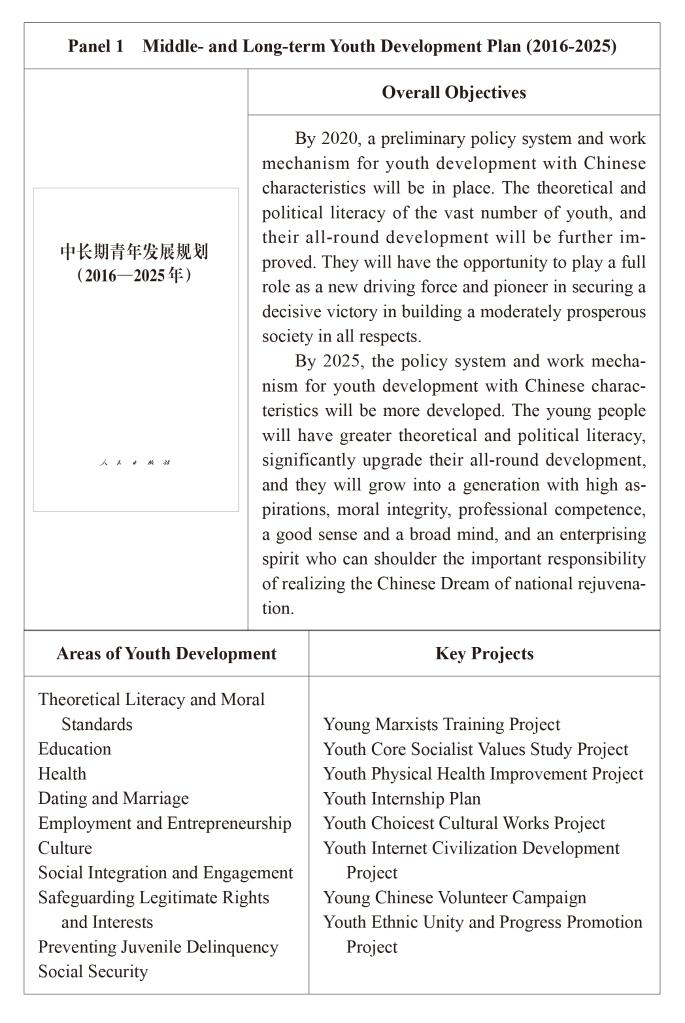
Improved social security services. As China has built the largest social security system in the world and further developed inclusive social security services, young people in China are shielded by social security when they enter the workforce, and free from various worries when pursuing their dreams. They can therefore live a more comfortable life, feel more at ease at work, and have greater confidence about the future. The government has introduced a series of policies to support flexible employment through multiple channels, gradually improved the social security services for those engaged in such employment, and supported young people in taking up flexible jobs. Housing supply for young people has been increased, and more big cities have increased the supply of government-subsidized rental housing for new urban residents and young people, mitigating housing problems for young people. The country is working towards an integrated national scheme for basic old-age insurance, and will continue to expand the coverage of such insurance policies as unemployment insurance and work-related injury insurance to young working population. Young people are better protected by the social security system.
Strong institutional safeguards and support. Organizations help young people grow and develop. As a CPC-led people’s organization composed of progressive young people, the CYLC has always prioritized safeguarding the rights and interests of young people, and their development opportunities. It has earnestly advocated the idea of prioritizing youth development, made full use of its organizational strengths and vigorously mobilized social resources to carry out policy advocacy on the pressing difficulties and problems that are of the greatest concern to young people. It has been doing its best to address specific problems by every means possible to create a good environment for young people to grow and develop. As one of the basic people’s organizations under the leadership of the CPC, the All-China Youth Federation has always represented and safeguarded the legitimate rights and interests of young people of all ethnic groups and all sectors of society, guided them in their active and healthy participation in public activities, and worked hard to help them healthily grow and prosper. As a federative body of student unions and graduate student unions at universities and colleges and student unions at secondary schools under the leadership of the CPC, the All-China Students’ Federation has voiced and safeguarded the specific interests of young students in accordance with the law and the Constitution of the Federation, and organized healthy, positive, and colorful extracurricular and community service activities to help them grow and develop.
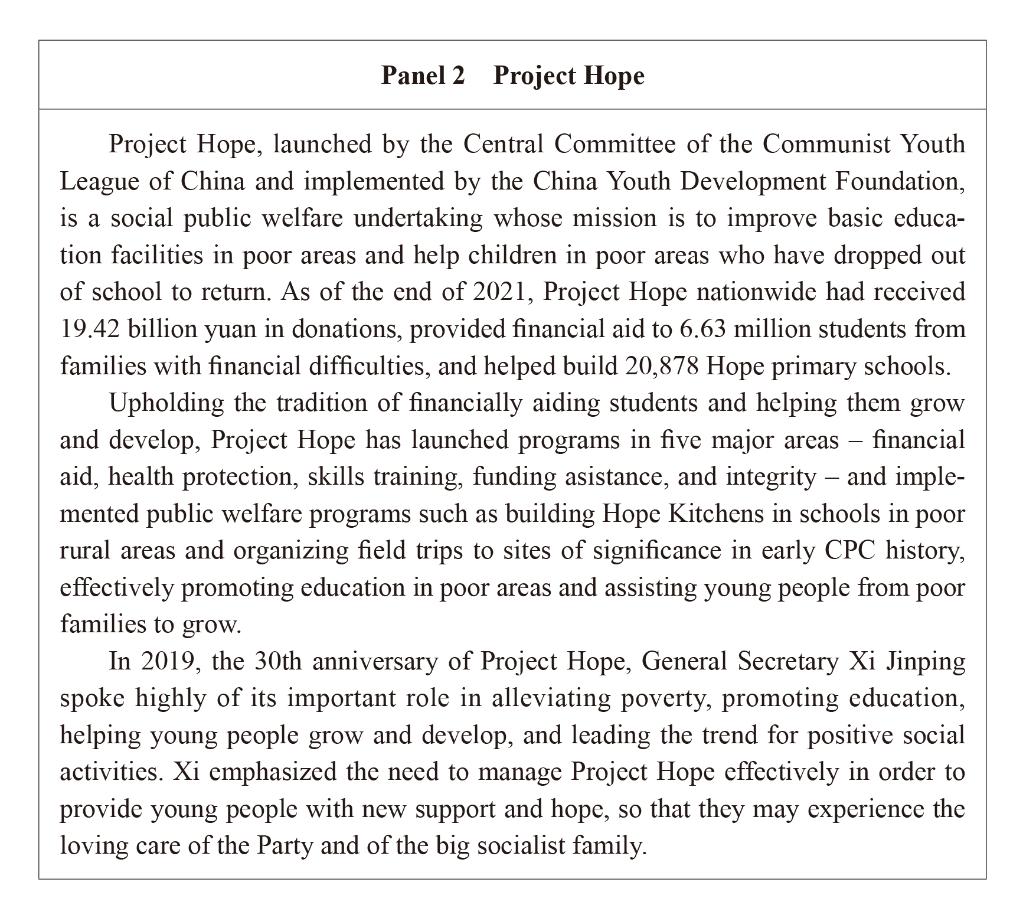
II. All-Round Development in the New Era
Hard work builds ability, and adversity builds resilience. In the new era, China’s youth actively study the theory and practice of science and other knowledge and skills, improving their physical and moral qualities and their all-round ability. They are growing into a new generation that is capable of shouldering the responsibility of national rejuvenation.
(1) Firmer in Ideals and Convictions
Ideals provide direction in life, and convictions determine the success of a cause. In the new era, young Chinese should hold lofty ideals and be firm in their convictions, which are fundamental to their success, and they should strive to become aspiring young people, living up to the expectations of the Party, the country and the people.
Confidence in the Chinese path. Through comparison with the past and the rest of the world, and through social observation and hands-on practice, young Chinese keenly understand the importance of the Party’s leadership and leader’s guidance, the merits of the socialist system, and the strength of the people. A youth survey conducted in 2020 demonstrated that the majority of China’s youth wholeheartedly support socialism with Chinese characteristics, and are full of confidence about the rejuvenation of the Chinese nation.
Under the guidance of Xi Jinping Thought on Socialism with Chinese Characteristics for a New Era, they have learned about China’s speed, the China miracle, and the governance of China through vivid examples and objective data showcasing the country’s achievements, and through their own personal experience. They become prouder to be a member of the Chinese nation, and are more determined to join forces and achieve the Chinese Dream – the rejuvenation of the Chinese nation.
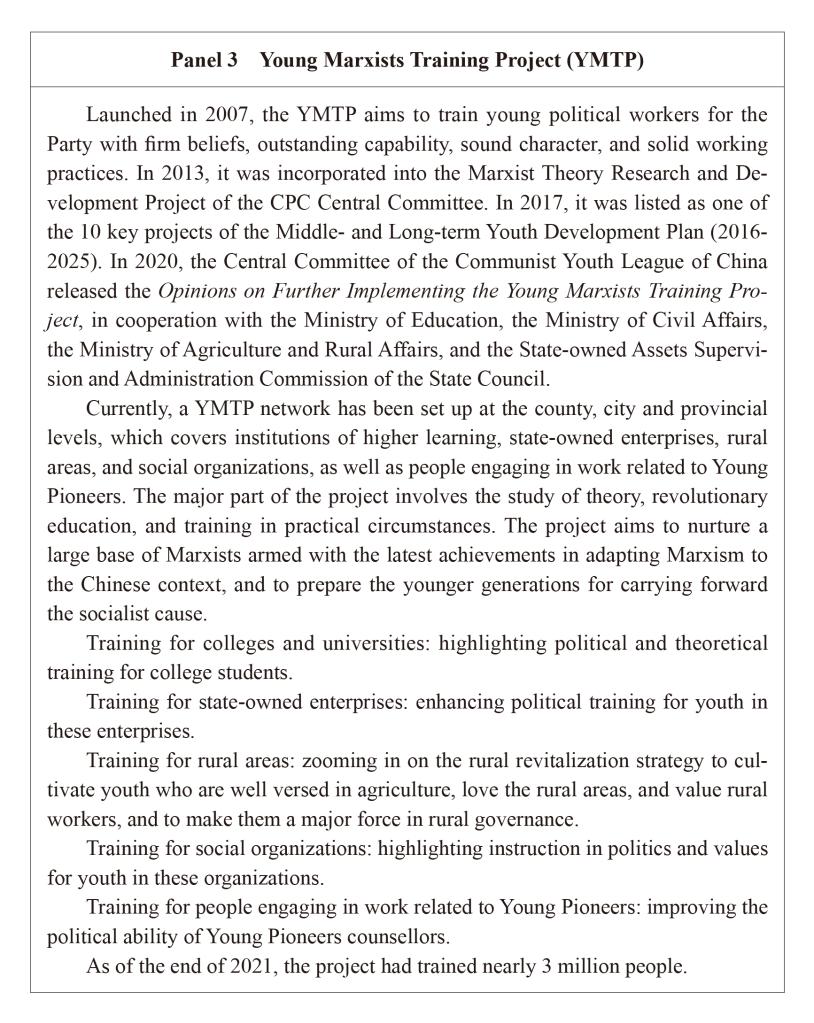
Commitment to core socialist values. The value orientation of youth will decide the values of the whole of society. Young Chinese learn morals and values from heroes and role models of our times. They proactively uphold and promote core socialist values – prosperity, democracy, civility, harmony, freedom, equality, justice, the rule of law, patriotism, dedication, good faith and amity. A large number of outstanding youth have become role models for others to emulate, including more than 1,500 youth who have been awarded the China Youth May 4th Medal, and Excellent Communist Youth League Members at various levels. More than 20,000 young people have been honored as Positive and Kind Youth for exuding positive youthful energy. Although sometimes confused by exchanges, mingling and clashes of ideas, young Chinese always love the Party and the country sincerely, and continue to pursue their lofty values and ideals.
Stronger cultural confidence. Culture is the soul of a nation, and strong cultural confidence is a vital foundation for realizing national rejuvenation. China’s youth draw nutrients from the best of China’s traditional culture, revolutionary culture, and advanced socialist culture, and gain strength from the time-honored Chinese civilization.
A youth survey in 2020 showed that more than 80 percent of the respondents believed that the reason for the enthusiasm for Sinology among youth and adolescents is that “Chinese citizens have begun to pay attention to the innate value of traditional culture”. Young people have switched from coveting foreign brands to preferring national ones, from wearing Western attire to wearing traditional costumes, and from favoring Western dance styles to traditional Chinese ones. Young Chinese identify more and more with the splendors of Chinese civilization. They are deeply proud of the Chinese nation, and are more active in promoting traditional Chinese culture and boosting cultural confidence across society.
(2) Better Physical and Mental Health
The key to China’s development lies in the younger generations. A strong body and mind are important for the healthy development of young people. Chinese youth in the new era are of the highest caliber. This is first reflected in their sound physical and mental health, which sustain them in trials and tribulations.
Improved physical health. In schools, as the class hours for physical education continue to increase, students study academic courses in class, and engage in physical activities on the playground. More than 37 million rural students receiving compulsory education have benefited from the student nutrition improvement program, and their physical health has markedly improved. In 2018, 92 percent of students aged between 14 and 19 passed the physical fitness test, and the proportion of those rated good or excellent increased substantially.
In communities, young people participate actively in mass sports. Running, swimming and ball games are popular. Sport and fitness venues are crowded. The Beijing Olympic Winter Games have boosted young people’s enthusiasm for winter sports in China. Youth aged 18 to 30 are the main force in winter sports, with the participation rate reaching 37.3 percent, the highest among all age groups.
In competitive sports arenas, especially in international events such as the Olympic Games and the Asian Games, Chinese youth have taken golds and silvers inspired by the Chinese Women’s Volleyball Team known for its unyielding spirit, living up to the new Olympic motto “Faster, Higher, Stronger – Together”. They have manifested the vigorous spirit of the Chinese nation. Chinese youth enjoy, value, and participate in sports, becoming an active force in building a country strong in sports.
Confidence and optimism. Young Chinese begin by doing small things around them, then work hard to turn their firm ideals and convictions, sound values, and strong cultural confidence into a healthy social mindset. Although they are under significant pressure in terms of employment, education, housing, dating and marriage, and often have to take care of elderly family members, yet with care and support from the Party, government and society, they rise up to the challenge.
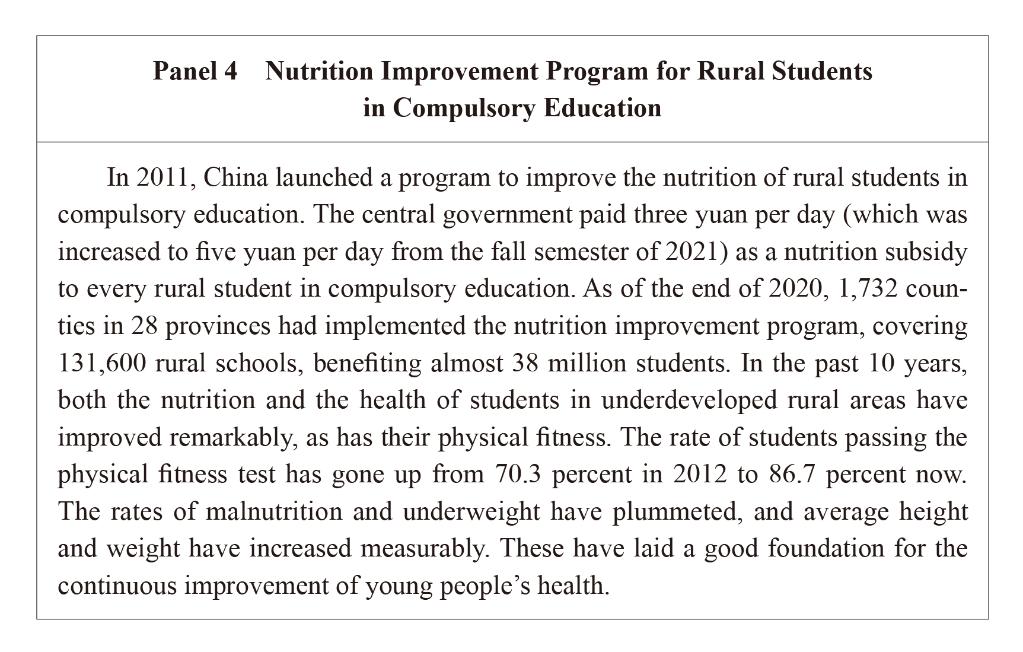
A 2021 questionnaire on the emotions of China’s young people showed that 88 percent of the respondents believed that they were capable of managing their emotions. China’s mainstream youth are confident about their future, and dream of and pursue a beautiful life. Confidence, optimism and self-motivation are their salient characteristics.
(3) Stronger Intellectual Foundations
Knowledge can shape one’s future and education may change one’s life. As China makes headway with its education programs, the younger generations have borne witness to and benefited from the historic progress. They have received a better education on a fairer footing; their enthusiasm for learning keeps growing and their scientific and cultural achievements have flourished.
A much better education. Thanks to the strategy for invigorating China through science and education and the strategy on developing a quality workforce, hundreds of millions of young Chinese have been provided with opportunities to tap their potential and hone their talents through education. This has enabled them to create a better life and realize their value.
Take 2020 for example. The new additions to the workforce that year had an average education of 13.8 years, 1.1 years more than a decade earlier. More than 50 percent of employees with college or higher education were young people while young employees accounted for only 30 percent of the total workforce. Receiving higher and better education is still one of the best ways for young Chinese to shape their future, realize their dreams, and attain their ideals.
Learning is becoming popular. More and more young people take delight in learning and make it part of their everyday life, fostering a positive atmosphere of self-improvement through continuous learning.
A large number of young graduates pursue advanced studies after leaving school. In 2020, the number of adults receiving continuing on-campus education exceeded 7.7 million and more than 8.4 million people received online college education. Enthusiasm for on-the-job training is also very high. Surveys show that more than half of young workers have taken vocational training, choosing to add to their knowledge base after work. Thanks to the fast-growing network media, they have more study choices available: through MOOC (massive open online courses) for instance.
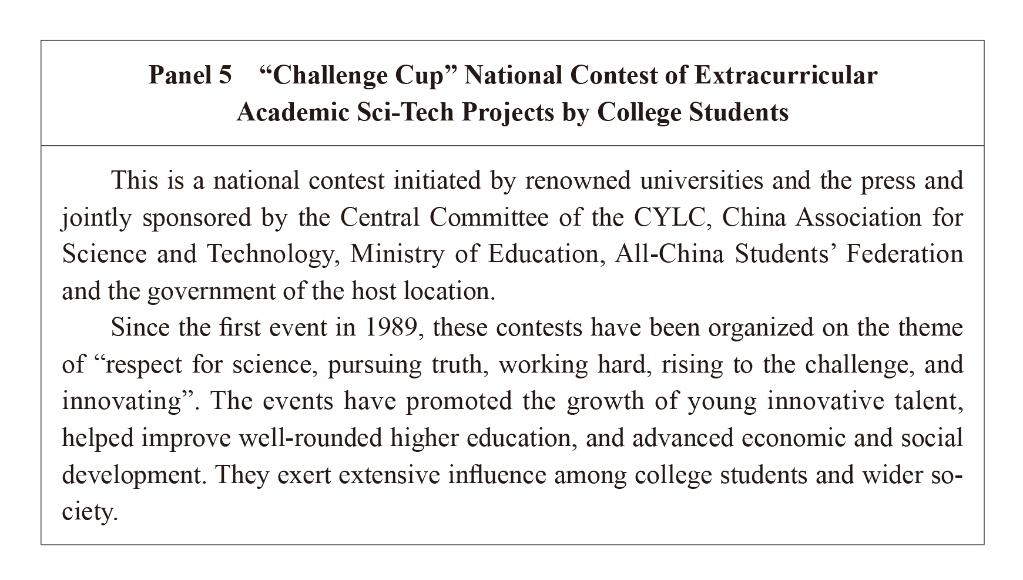
(4) Active Participation in Social Activities
Society offers an important space for young people to learn and practice skills. The younger generations of the new era have actively adapted to and integrated with society with more confidence and kept pace with social progress, displaying an acute sense of participation in society and the skills required, and acting as advocates and creators of positive energy.
Participation in political activities in an orderly manner. The younger generations are actively involved in politics and in China’s application of whole-process people’s democracy. Inspired by the lofty ideals of communism, they work hard and forge ahead, and an increasing number of them have applied to join the CPC and CYLC organizations.
By June 2021, the CPC had nearly 24 million members under the age of 35, accounting for 25 percent of its total membership. More than 80 percent of the CPC members admitted each year since the Party’s 18th National Congress in 2012 were under 35. The number of CYLC members (age range: 14-28) almost reached 74 million at the end of 2021.
A large number of young people have served as deputies to the people’s congresses or as members of the Chinese People’s Political Consultative Conference (CPPCC) committees at all levels. Through these organizations they have performed their duties and participated in the deliberation and administration of state affairs. In 2019, young people accounted for 10.9 percent of the deputies to the county-level people’s congresses and 13.7 percent of the county-level CPPCC committees. Young people are active participants in democratic elections, decision-making, management and oversight, making suggestions on major issues relating to economic and social development, and exercising their democratic rights and engaging in consultation to reach agreement on issues concerning youth.
Active participation in social programs. In recent years, a growing number of young people have taken part in charity and public-welfare activities, providing services in the communities, protecting the eco-environment, conducting cultural programs, and offering elderly care and assistance to people with disabilities. While playing an important role in influential social organizations, they have also set up self-management and self-service bodies.
At present, there are more than 7,600 county-level organizations of volunteers or artistic and sports organizations for young people, which are operating under the guidance of the CYLC. With these as the driver, more than 150,000 youth organizations have been set up, covering all counties. Through such organizations, young people have played a constructive role in providing many public services on behalf of the government, enforcing industrial discipline, meeting diverse public needs for services, leading socially conscious lifestyles, and promoting communication between the public and the government. All of this displays their strong sense of participation and social responsibility.
III. Shouldering Heavy Tasks and Responsibilities
The new era of socialism with Chinese characteristics is a grand stage on which young people can enjoy bright prospects and accomplish great things. In the new era, China’s youth are striving to support high-quality economic growth, participate in the development of socialist democratic politics, create a flourishing socialist culture, promote socialist moral and ethical progress, and build a beautiful China. They are working hard and forging ahead boldly on this new quest to realize the second centenary goal of building a modern socialist country.
(1) Dedicated in Grassroots Work Posts
In the new era, respecting the PRC’s great tradition of “perpetual struggle”, treating their grassroots work posts as a stage to realize the value of their life, and applying their diligence, young Chinese are working for social progress and striving for happiness, national rejuvenation, and a bright future for the country.
Young people work in various fields – conventional fields such as industry, agriculture, commerce and the military, as well as in science, education, culture, health, and sports, and now in internet-based new business models, areas and occupations. Through their hard work in their grassroots work posts, they have turned the ordinary into the extraordinary, and make the impossible achievable.
In factory workshops, young workers hone their skills and strive for excellence. They tighten every screw and weld every joint to perfection. They vie to be “young people who excel at their jobs” and they help “made-in-China” gain a competitive edge in the global market. In rural areas, young farmers cultivate the fields meticulously, increase grain yield and field fertility with technology, and work hard to ensure food security. On construction sites, young migrant workers painstakingly work all hours of the day and night to build skyscrapers, making the city more beautiful. At training venues, young athletes train hard and persevere in spite of all difficulties. With sporting prowess and indomitable spirit, they strive for Olympic games medals and see China’s national flag being raised at the awards ceremony. In city streets, couriers and takeaway delivery riders brave wind and rain to pass on happiness and warmth. Their sweat and toil demonstrate that Chinese youth have not forgotten the hard times, even though they now live in better days and no longer need to worry about food and clothing. They work hard and shine in their grassroots posts.
(2) Leading the Charge in Difficult Situations and Emergencies
In the new era China’s youth have shown no fear of difficulties and hardships in times of crisis, displaying their grit at critical moments. They rise to the occasion whenever the country and the people need them; they shoulder their responsibilities, make selfless contributions, and press ahead with the intrepidity typical of their generation.
Young people stand at the forefront in major projects emblematic of China’s composite national strength and national pride, in catastrophic natural disasters, and in other emergencies.
Youth teams have played a prominent role in the strategic projects that transport natural gas and electricity from western to eastern regions, divert water from the south to the north, and channel computing resources from the east to the west, as well as the construction of many milestone facilities, including the Hong Kong-Zhuhai-Macao Bridge, Beijing Daxing International Airport, and Hualong One nuclear generator.

During the Covid-19 pandemic, young people have been risking their lives to combat this deadly disease. More than 5.5 million of them in 320,000 task groups have worked on the front lines of this combat, providing medical care, transporting supplies, and building facilities. They have made a tremendous contribution to the all-out people’s war on the virus. Of the 28,600 nurses from the medical teams sent to Hubei, 90 percent were born between 1980 and 1999. During the construction of the Huoshenshan and Leishenshan hospitals in Wuhan, young workers, who accounted for 60 percent of the workforce, established 13 task groups to spearhead the project. With an iron will and boundless courage, they created an engineering miracle. This was a shining example of how young Chinese can hold their own in the face of difficulties, face down threats, and rise to the challenge at critical moments.
(3) Tempering Themselves Through Community Service
The local community is the best place to temper young people in the new era, where they can learn through practice. By aligning their personal ambitions with the grand goals of the state and the Party, young people turn their pursuit of the Chinese Dream into pragmatic work, and hone their skills and increase their abilities through trial and experimentation.
Helping villagers solve problems in rural areas, providing services to residents in cities, and patrolling and guarding the frontiers … More and more young people are now working in communities and in the places where they are most needed, fighting hardship to drive China’s modernization and realize their dreams.
Of the 1,981 individuals and 1,501 groups commended by the central authorities in 2021 who had stood out in China’s poverty alleviation campaign, many were young people. More than 1,800 people have died in the battle against poverty, and many of them were young people.
As the country implements the rural revitalization strategy, young people have led the efforts to establish specialized cooperatives, apply modern agricultural technologies, and develop new industries and new forms of business in rural areas. They have taken the lead in abandoning outdated social mores, nurturing civil social norms of conduct, and improving rural living environments, and helped villagers increase their incomes. All of these have contributed to giving rural areas a bright new image.
By 2021, 470,000 college graduates had worked in rural areas on posts related to teaching, agriculture, medical service and poverty alleviation, and during their vacations, millions of college students had conducted surveys or taken part in cultural activities and other activities to spread understanding of science and technology and information on health in the countryside. Through these efforts, young people have offered their support to China’s poverty alleviation and rural revitalization.
(4) Taking the Lead in Innovation and Entrepreneurship
In the new era, China’s youth have shown rich imagination and creativity, open-mindedness, and a pioneering spirit. They have the spirit to engage in the field of international competition as it grows ever fiercer, and have become a strong force driving innovation and entrepreneurship.
Backed by policy incentives of the Party and the state, young people take the lead in innovation, starting businesses, and striving for excellence, serving the country and the people with their ingenuity and expertise in economic, social, technological and cultural fields. Under the innovation-driven development strategy and open competition mechanisms, a large number of world-class young scientists have come to the fore in major sci-tech programs, including China’s space station Tiangong, deep-sea manned submersible Jiaolong, the five-hundred-meter aperture spherical telescope (FAST) Tianyan, the dark matter probe satellite Wukong, the quantum science satellite Mozi, the Mars probe Tianwen-1, and the lunar mission Chang’e. The average age of the core members of the research groups on the Beidou Navigation Satellite System is 36; the corresponding figures are 35 for Mozi and 30 for Tianyan. Every year more than 3 million science and technology and engineering students graduate from Chinese universities, which continuously replenish the country’s ranks of engineers. Well-educated and highly-skilled, they give China an “engineering bonus”, adding impetus to the country’s development and improving its standing in international competition.
China has introduced a raft of policies supporting business startups, and young people are responding warmly. They are active in entrepreneurship programs like the China College Students’ Entrepreneurship Competition, China International “Internet+” College Students Innovation and Entrepreneurship Competition, carving out careers with their knowledge and ingenuity. Among the founders of market entities registered since 2014, more than 5 million are college students and new graduates. In creative industries such as IT services, culture, sports, entertainment and sci-tech, young people account for half or more of the workforce, and are at the helm of many unicorn and gazelle companies. Aligning individual inclination with national development, young people are putting their talents to use in innovation and starting businesses, and serving society in the process.
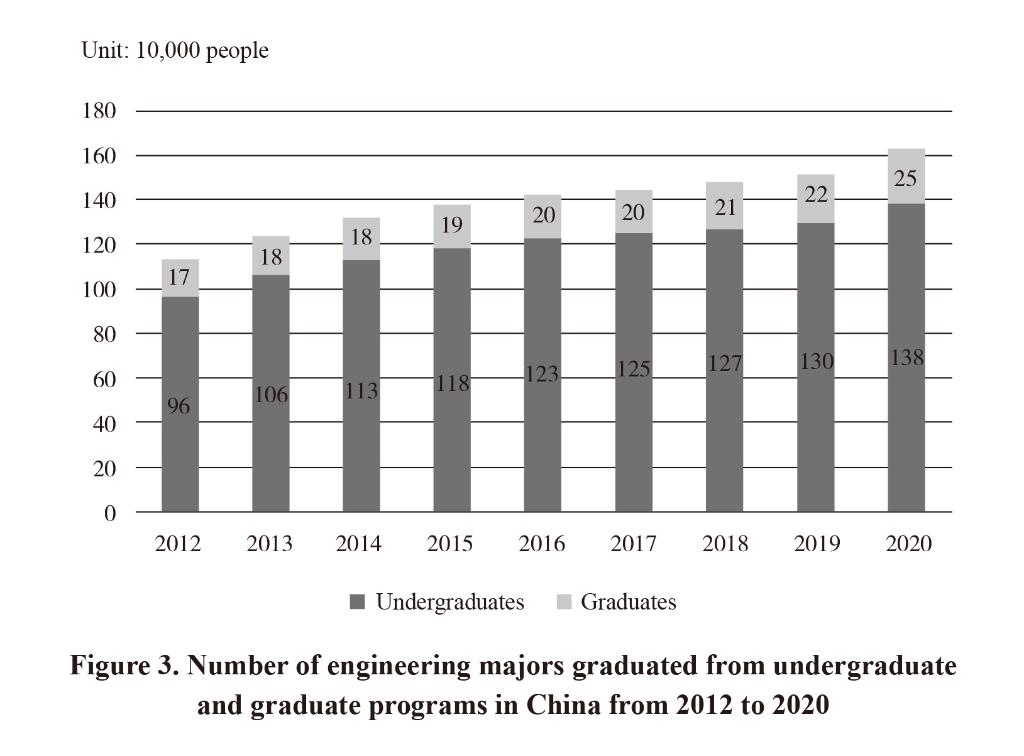
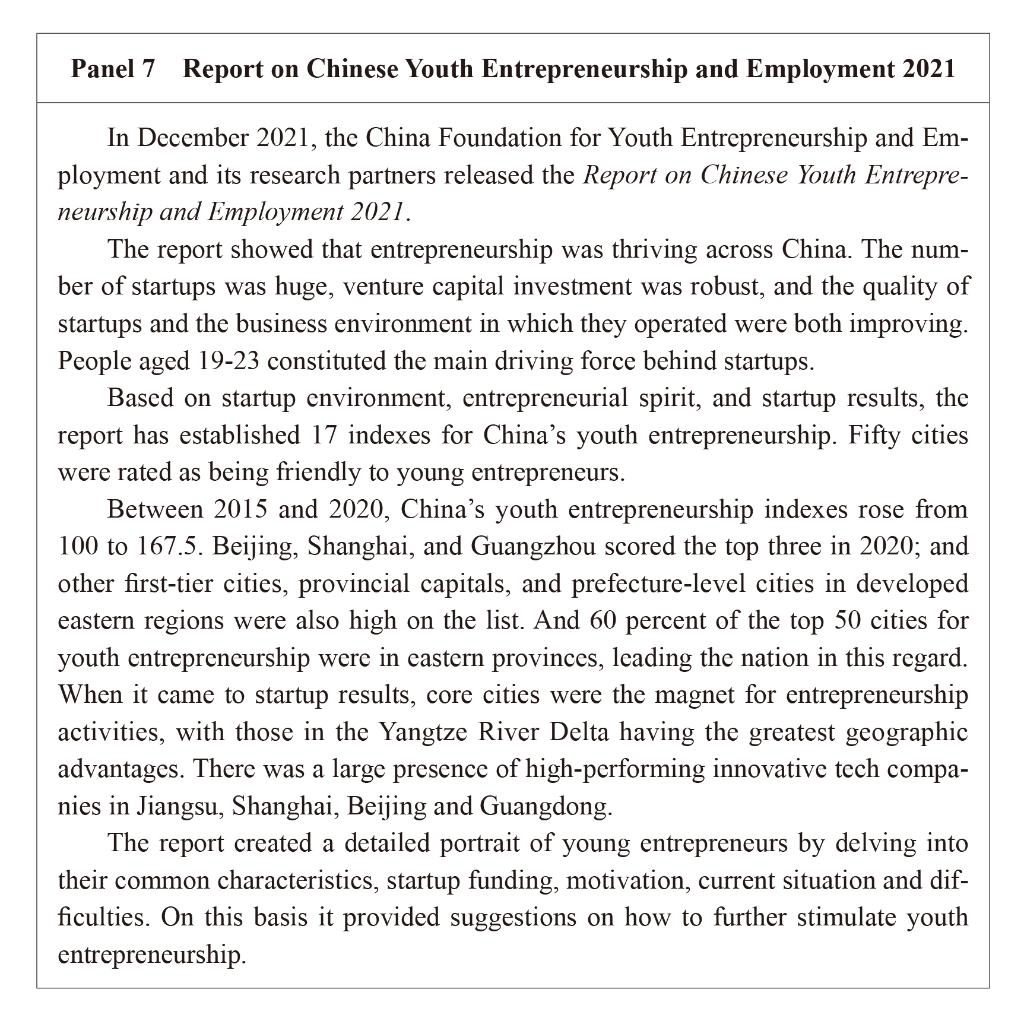
(5) Spearheading Cultural and Ethical Progress
In the new era China’s youth advance with the times, adapt to the need to modernize China’s system and capacity for governance, and set the pace in making cultural and ethical progress. They advocate and follow new, positive trends.
In both urban and rural areas, in the workplace or on campus, young people embrace good moral values and ethical conduct. They champion pursuit of excellence and the greater good, and set healthy trends.
A growing number of young people are engaged in community governance and services in both urban and rural areas. By participating in programs like Youth Action in Communities launched by the CYLC Central Committee, they gain practical experience, and improve their ability to serve society. In all sectors of the economy, young people work in a spirit of dedication, collaboration, excellence and contribution, and have created many model worker teams. They represent the work ethic and professionalism of the new era. Young athletes, demonstrating good sportsmanship, score excellent results at games.
Since the China Young Volunteers initiative was launched in 1993, volunteering has become an important avenue for young Chinese to participate in social governance, fulfill social responsibilities, and temper themselves in the course of serving the people and society.
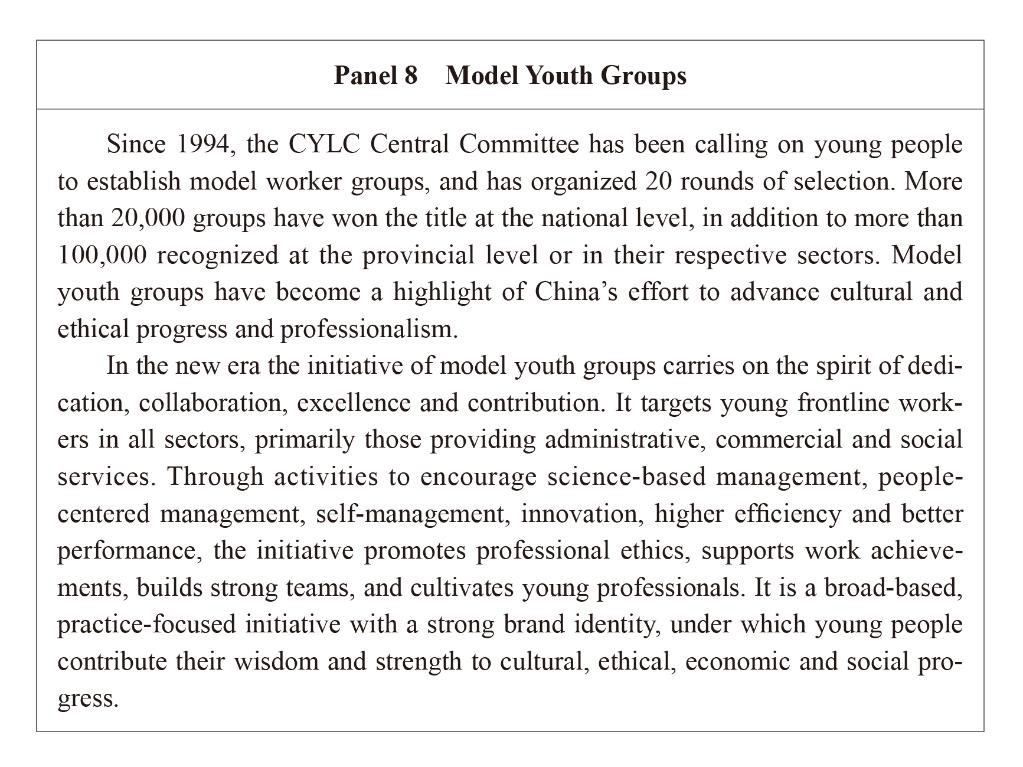
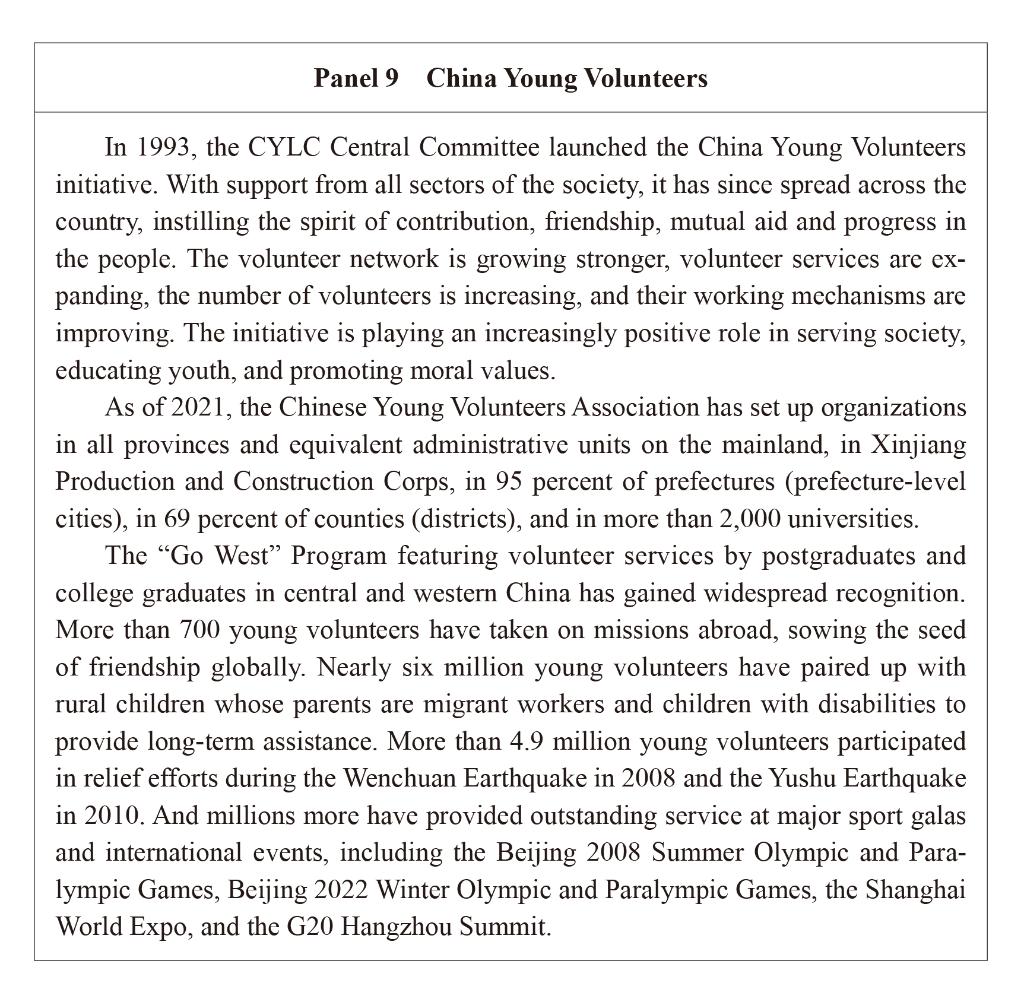
As of the end of 2021, more than 90 million people aged between 14 and 35 had registered at the volunteering platform Chinavolunteer.mac.gov.cn. They are active in community affairs, large sport events, environmental protection, development-driven poverty alleviation, healthcare, emergency response and cultural preservation. By spreading the spirit of volunteerism – contribution, friendship, mutual aid and progress – they promote unity, equality, amity, mutual aid, and common progress across the society.
Over the past 18 years, China’s “Go West” Program has dispatched 410,000 postgraduates and college graduates to 2,100 counties in central and western regions to support poverty reduction endeavors there through teaching and healthcare service. Young people have always been the mainstay of volunteers providing services in large-scale events. They have made a deep impression on the world.
IV. Having a Global Vision and a Strong Sense of Responsibility
The younger generation is the future of a country and the hope of the world. China’s youth in the new era care about their family and country, and share that concern for the rest of humanity. They uphold the beliefs advocated by Chinese culture that all peoples are one family and the world is a commonwealth. They actively draw inspiration from the experience and achievements of other countries and civilizations. They work along with their peers from around the world to build a global community of shared future, and advocate peace, development, equity, justice, democracy and freedom, which are the common values of humanity, for the purpose of creating a better future for all.
(1) Embracing the World with Greater Openness and Confidence
As China opens its doors wider to the outside world, the country’s young people today are building a greater understanding of international exchanges and cooperation. They are embracing the world, pursuing broader and deeper integration with others, and showing greater rationality, inclusiveness, self-confidence and self-reliance, by studying, working, traveling, and participating in visiting programs abroad.
Studying abroad is the most important way for Chinese youngsters to learn about the world. In 1978, China sent just over 800 students abroad. In 2019, more than 700,000 Chinese students went abroad to undertake education courses. Over the past four decades, the total number of Chinese people studying abroad has exceeded 6.5 million. The number of Chinese overseas returnees grew from 248 in 1978 to more than 580,000 in 2019. The total number of overseas returnees has exceeded 4.2 million in the past more than four decades. In addition, a large number of Chinese young people go abroad for travel, visiting programs, business tours, and labor cooperation, which enable them to better understand the world. In 2019 alone, Chinese citizens made 170 million overseas trips. The channels for Chinese youth to know about the world continue to expand, and their global vision is steadily broadening.
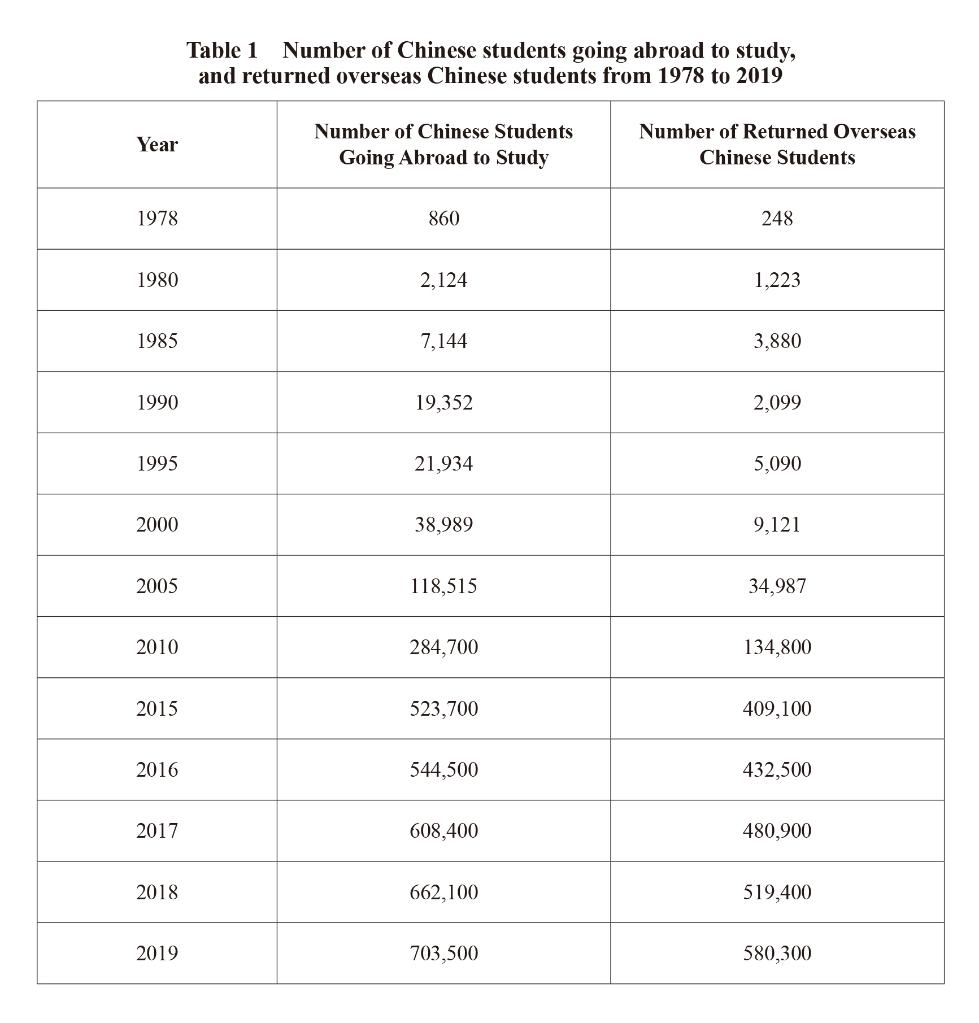
The “circle of friends” with whom China can communicate and cooperate continues to grow. China’s youth seize every opportunity to tell China’s stories and participate in global governance of youth affairs in various international arenas, and promote win-win cooperation through active exchanges and interactions under bilateral and multilateral frameworks. As young Chinese people take a more active part in bilateral exchange mechanisms, they become closer to their peers in other countries and build deeper bilateral ties. Under the framework of the Chinese Youth Global Partnership, China has established exchange and cooperation relationships with more than 100 international organizations, government youth agencies, political parties, and non-governmental youth organizations. Chinese youth are engaged in frequent international exchanges in fields like education, science, culture, arts, sports, and the media under the cultural and people-to-people exchange mechanisms between China and other countries and regions such as Russia, the United States, Europe, India and Japan. China’s youth and their partners in neighboring countries and developing countries carry out cultural and people-to-people exchanges that bring fruitful results; they also achieve mutual benefit through incubating startups, promoting economic and trade cooperation, advancing technological exchange, and other efforts. China’s young people have become more active in joining international organizations, attending international conferences, and participating in global governance. As a result, they have succeeded in enhancing the international image of China’s youth.
Hundreds of young people from China work hard for the UN and other international organizations and contribute to world peace and development. China’s young people are growing in confidence as they spread China’s voice and express China’s ideas at the UN Youth Forum, the UNESCO Youth Forum, and other multilateral mechanisms and in international youth organizations such as the Asian Youth Council. This allows them to serve as young ambassadors of Sino-foreign friendship.
(2) Meeting the Responsibility to Build a Global Community of Shared Future
Young Chinese of the new era are fully aware that the future of each and every nation and country is interlocked. We should stand together and help each other in the face of adversity, and endeavor to build this planet of ours into a single family of shared future.
Building consensus among youth through heart-to-heart communication and dialogue. Young Chinese actively advocate and practice the idea of building a global community of shared future. They are committed to telling the stories of global youth, spreading the voice of global youth, and building consensus among global youth on issues such as poverty alleviation, climate change, and anti-Covid cooperation. In 2020, at an online seminar on Covid-19 organized by the World Health Organization and other UN agencies, a young representative of China shared her moving story as a volunteer, recounted some experiences, and explained China’s science-based response to the epidemic. Young Chinese also contribute their wisdom and ideas for safeguarding global youth rights to subsistence, development, protection and participation in the process of formulating documents on youth cooperation under international mechanisms such as the Shanghai Cooperation Organization, BRICS, and G20. During the Beijing 2022 Olympic and Paralympic Winter Games, the youth volunteers of China and young athletes from many countries overcame language barriers and cultural differences as they expressed goodwill with smiles, build friendships through personal contact, and pooled their strengths through heart-to-heart communication. Those young people worked together to build bridges towards a shared future, and spread the vision of building a global community of shared future around the world in their own way.
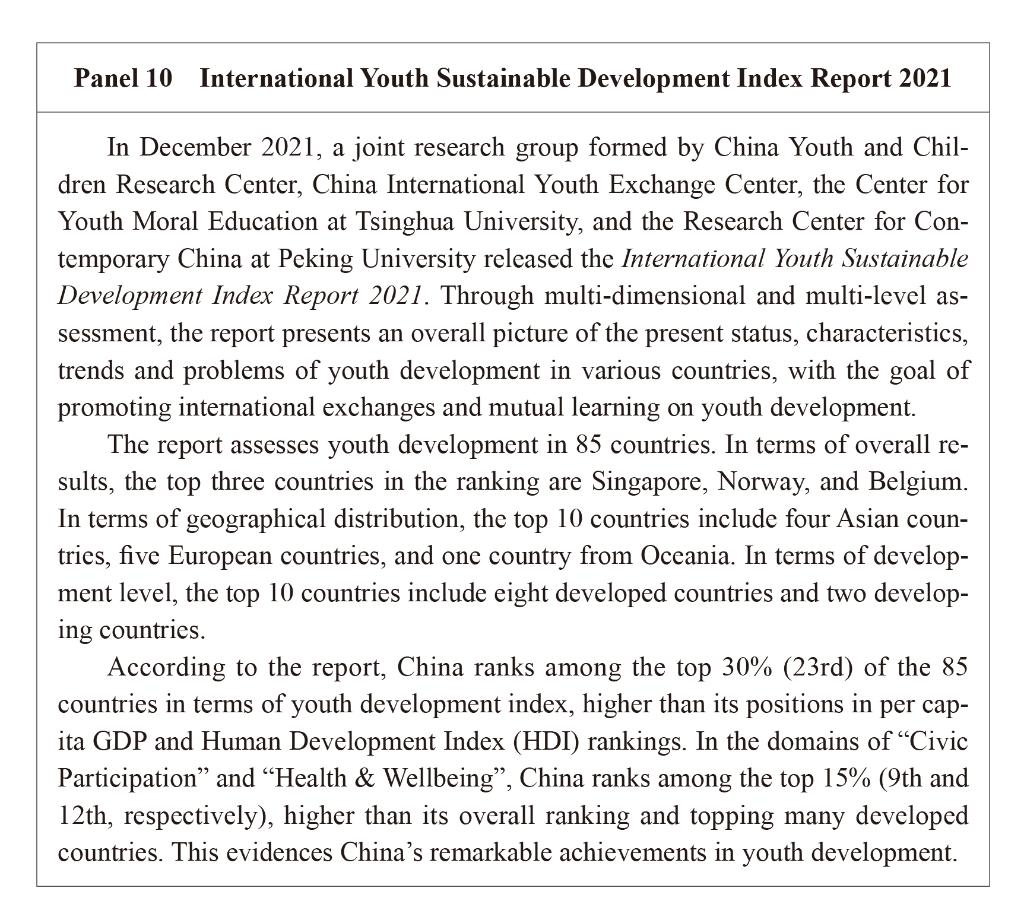
Hand in hand on the journey towards a brighter future. China’s youth firmly bear in mind the concept of building a global community of shared future, and actively implement it in practice. They devote themselves to the construction of the Belt and Road while following the principles of “extensive consultation, joint contribution and shared benefits”. Hundreds of thousands of young employees in Chinese companies operating overseas work hard in foreign lands far from home, contributing to local economic and social development. They also take an active part in volunteer services, charitable donations, and cultural exchanges, building friendships and cooperation with young people in the host countries. At present, many volunteer Chinese teachers, most of whom are young people, are working in more than 100 countries to help youth in other countries to study Chinese culture. The China Youth Volunteer Overseas Service Program has sent more than 700 young volunteers to over 20 countries in Asia, Africa, and Latin America to provide services in areas like medical care, agricultural technology, civil engineering, industrial technology, economic management, and social development. Demonstrating a great love for humanity and upholding a spirit of humanism, young Chinese soldiers actively participate in UN peacekeeping missions; they have made their contributions to defending world peace. By 2020, China had dispatched more than 40,000 peacekeepers, and 16 of them, under the age of 30 on average, had sacrificed their lives. The actions of Chinese youth have demonstrated that as long as people around the world unite with one heart and one mind and move forward hand in hand, we will build a global community with a brighter future.
(3) Global Action Initiative of China’s Youth
Humanity has entered a new era of interconnection, with countries sharing common interests and their futures closely linked. Across the globe greater deficits of governance, trust, peace and development are emerging, and we are seeing escalating chaos, discord and injustice. Profound changes of a scale unseen in a century, together with the Covid-19 pandemic, are presenting grave challenges to the global economy and people’s prospects of a better life. Humanity has found itself at a crossroads: peace or war, light or darkness, progress or regression – there are significant choices that we need to make. The era calls on global youth to unite with one heart, strengthen mutual understanding, learn from each other, view the world from the angle of mutual appreciation, mutual learning, and mutual benefit, so as to jointly build a global community of shared future. China’s youth therefore call on young people around the world:
– To uphold the values of beauty, uprightness, and goodness. Young people should set themselves lofty ideals and conduct themselves with moral integrity. They should follow the right path, value kindness, goodness, and beauty, have an ardent love for life, and contribute to society. They should make every possible effort to promote truth and spread positive energy.
– To maintain a spirit of youth and vigor. Young people should be self-confident, self-reliant, and high in spirits. They should seek to improve and extend themselves, fulfill their dreams, and show their worth, and strive to present themselves in the best possible light. They should advocate healthy lifestyles, pursue physical and mental health, foster a sound outlook, and maintain vigor.
– To shoulder the responsibility for national development. Young people, as masters of their respective countries, should study hard to improve their skills and abilities, leverage their wisdom, and be bold in innovation. Ready to struggle and willing to work hard, they should be at the forefront of the times and shoulder the historic mission to realize the development and progress of their countries.
– To contribute wisdom and strength to world peace and development. With the world and the future in mind, young people should uphold the common values of humanity, set the trends of history and lead the tides of the times, and stand on the side of fairness, justice, and human progress. They should safeguard world peace, promote common development, defend democracy and freedom, and make a greater contribution to building a prosperous, beautiful world.
China’s youth look forward to a world of peace, stability, development and prosperity. They expect every country and region to provide favorable conditions for youth development, and hope all young people across the globe will shoulder their responsibilities and contribute their wisdom and strength to building an open, inclusive, clean, and beautiful world that enjoys lasting peace, universal security, and common prosperity.
Conclusion
A country will be full of hope and can look forward to a bright prospect when its young generation has ideals, abilities, and a strong sense of responsibility. The future of China and the future of the wider world both belong to the young.
In the future, the young Chinese generation will “with their youthfulness, create a vibrant family, country, nation, human community, Earth and the universe.” They will make their youthful dreams come true.
In the future, with successive efforts from one generation of young people to the next, China will scale new heights in every dimension, achieving economic, political, cultural, ethical, social, and eco-environmental progress. The Chinese people will enjoy a happier and healthier life and the Chinese nation will become a proud and active member of the community of nations. The great Chinese Dream will eventually become a reality.
The future of the world is related to the destiny of every young person, and it also depends on the efforts that every young person makes. If young people from all countries unite for the common goal, uphold justice, work in harmony, help each other, conduct consultation as equals, and commit to openness and innovation, we will be able to steer clear of strife and war, build a “global village” that pursues peaceful development and harmony, jointly create a future of prosperity, health, safety, mutual respect, mutual learning, and shared benefits, and ultimately realize the common dream of all of humanity.
China’s youth stand ready to work with their counterparts from all over the world and contribute their wisdom and strength to building a global community of shared future and a better world.


